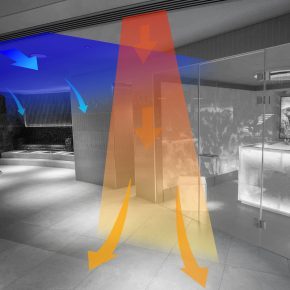
Ligatures: Contour discusses the risks you should be aware of
Contour Heating discusses the importance of addressing ligature risks in mental health settings.
Architects, specifiers and ward managers should closely observe any ligature risk- no matter how big or small-when redesigning or upgrading their facility, as suicide statistics in mental health settings demonstrate that three-quarters of patients who kill themselves on a psychiatric ward do so by hanging or strangulation.
Ligature Risks: Key Examples
Even the smallest risk must be identified, and measures put in place to minimise. Some examples of risks are as follows:
- Power cords on medical equipment
- Call bell cords
- Handrails
- Doors
- Doorknobs
- Door hinges and hardware
- Showerheads and curtains
- Exposed plumbing or piping
- Paper towel and soap dispensers on walls
- Electrical switches
- Lighting fixtures
- Projections from ceilings
Managing Identified Risks
It’s extremely difficult, and in some cases impossible, to completely remove ligature risks. Doing so may serve as a hindrance for employees carrying out necessary tasks, and for service users by taking away their rights of independence.
In managing risks, it is recommended that you take a ‘remove, replace, protect, or manage’ approach, as highlighted by The Nottinghamshire Healthcare NHS Ligature Risk Reduction Policy (2019).
Remove, Replace, Protect, Manage
Remove – If the risk would leave the patients at risk, the ligature should be removed and there is no suitable alternative.
Replace – The ligature Is removed and replaced with a purposely designed similar anti-ligature piece of equipment.
Protect – Provide materials that hide the potential ligature.
Manage – There is a need to keep the risk because of the potential injury is greater than the potential of an attempted suicide, for example, grab rails within an elderly in-patient/dementia unit.
Examples Of Ligatures and Ligature Point Risks To Consider
Before we head into the examples, it’s important to understand the distinction between ligatures and ligature points.
A ligature is anything that binds or ties, such as chains, linen, clothing, cords, tubing, etc. Whereas, a ligature point is anything that could be used to attach or secure a ligature, such as shower rails, coat hooks, water pipes, door frames, etc.
Potential ligatures and ligature points and potential risk control
Bedsteads – Should be appropriate to the environment
Brackets, picture rails, ventilation grilles, ducts – Brackets: remove, box in or chase into wall
Grilles: perforations should be a maximum of 3mm in diameter
Coat hooks – Remove all hooks behind doors, in wardrobes, etc
Curtain rails – Collapsible rails and safety track
Curtain tracking – Avoid gaps in fixed tracking
Curtain wires – Avoid use of curtain wires
Doors (closers, handles, frames) – Careful consideration of design
Electrical wiring – Should be ‘chased’ into wall or fitted flush to wall
Exposed pipework – Consider height and accessibility
Hinges – Consider types of hinges and gaps between doors and frames
Light switch cords – Should not be nylon. Consider solid pull cords or infra-red automatic switches
Consider anti-ligature light switch covers
Patient’s lockers/wardrobes – Remove hanging rails
Radiators – Consider boxing in with appropriate covers
Wardrobes – Consider design (handles, internal hooks, door closing etc)
Window and window openings – Consider handles, trickle vents, hinges
Window and door weatherproof seals – Consider ligature points
Sink taps, plugs – Consider ligature points
Smoke detectors – Consider ligature points or appropriate covering
When assessing ligature risks, consider the use of the outdoor environment too. Anchor points in the garden may include windows, drainpipes, fencing, and trees.
Contour’s range of anti-ligature products are designed to help minimise the risk of self-harm and suicide in mental health settings, providing Service Users with a safe and secure environment.
Contour can be contacted at;
The Mansions
43 Broadway
Shifnal
TF11 8BB
Tel: 01952 290 498
Email: sales@contourheating.co.uk
Visit Supplier's page
Latest news

2nd April 2025
FIT Show 2025 Launches Innovative Marketplace Feature to Enhancing Value for Installers
FIT Show, the UK’s leading event for the window, door, flat glass, hardware, and roofing industries, is excited to announce the launch of a brand new Marketplace feature at its upcoming 2025 event (Birmingham NEC, 29 April – 1 May).
Posted in Architectural Ironmongery, Articles, Building Industry Events, Building Industry News, Building Products & Structures, Doors, Exhibitions and Conferences, Glass, Glazing, Hand Tools, Innovations & New Products, Plant, Equipment and Hire, Power Tools, Restoration & Refurbishment, Retrofit & Renovation, Roofs, Seminars, Training, Windows
2nd April 2025
Hi-spec deployment of EJOT Colorfast at new Birmingham logistics park
EJOT Colorfast fasteners have been used extensively in the construction of eight new high-specification warehousing and logistics buildings at the Urban 8 Logistics Park in King’s Norton, Birmingham.
Posted in Articles, Building Industry News, Building Products & Structures, Building Systems, Case Studies, Facades, Restoration & Refurbishment, Retrofit & Renovation, Roofs, Walls
2nd April 2025
SWA member delivers ‘fresh Hope’ for university’s Sustainable Building department
A detailed contract to restore an iconic Art Deco building in the heart of Birmingham’s Jewellery Quarter was carried out by Steel Window Association member, The Window Repair Company (Northwest) Limited.
Posted in Articles, Building Associations & Institutes, Building Industry News, Building Products & Structures, Building Systems, Case Studies, Glass, Glazing, Restoration & Refurbishment, Retrofit & Renovation, Steel and Structural Frames, Sustainability & Energy Efficiency, Windows
1st April 2025
Gilberts Takes Thermal Comfort to New Heights
Gilberts Blackpool is continuing to build on its reputation as a pioneer with the unveiling of ThermaAstute™ – the most extensive range of thermally sensitive diffusers in the market.
Posted in Air Conditioning, Articles, Building Industry News, Building Products & Structures, Building Services, Facility Management & Building Services, Heating, Ventilation and Air Conditioning - HVAC, Innovations & New Products, Restoration & Refurbishment, Retrofit & Renovation, Sustainability & Energy Efficiency
 Sign up:
Sign up: